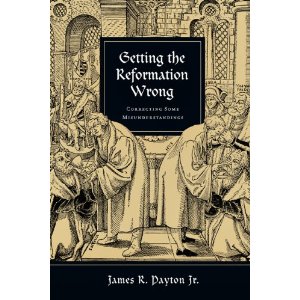 If you are a Reformation-history buff like me, you will be interested in a new book by James Payton. Getting the Reformation Wrong: Correcting Some Misunderstandings (IVP, 2010) is Payton’s attempt to set the record straight on Reformation history and theology. Though the title is Getting the Reformation Wrong, Payton is not as interested in pointing out flaws in Reformation interpretation as he is making a positive case for why we should try to get the Reformation right.
If you are a Reformation-history buff like me, you will be interested in a new book by James Payton. Getting the Reformation Wrong: Correcting Some Misunderstandings (IVP, 2010) is Payton’s attempt to set the record straight on Reformation history and theology. Though the title is Getting the Reformation Wrong, Payton is not as interested in pointing out flaws in Reformation interpretation as he is making a positive case for why we should try to get the Reformation right.
The first chapter records the historical backdrop of the Reformation. Payton describes how fear of plague and warfare engulfed the population. He also describes the weakened state of the papacy and the lack of moral credibility of the Catholic Church. Payton claims to correct the misunderstanding that the Reformation simply dropped out of the sky from heaven. Instead, he says, we should see the movement as a groundswell of response to the call for reform, a call which had been echoing for a couple of centuries. This introductory chapter succeeds at putting the Reformation into historical context, but is less persuasive as the correction of a misunderstanding. (I’ve never heard anyone make the case that the Reformation originated in the way Payton describes.)
In chapter two, Payton criticizes the idea that the Renaissance was a secularist, humanistic parallel to the spiritual, God-centered Reformation. Instead, we should see the Renaissance as a friend, not a foe, to the Reformation.
Next, he writes about Martin Luther and his conflicts with the other Reformers. The chapter is filled with good information, yet I doubt that this misunderstanding (that the Reformers were all united on every point) is very widespread. Most Reformation history books lay out the different views of the Reformers. Payton is right, however, to note that though the Reformers had conflicts, they were united on essential doctrines that distinguished them from the Catholic Church.
The best chapter in this book evaluates what the Reformers meant by sola fide (faith alone). Payton argues against an understanding of “faith alone” that would divorce faith from its fruitfulness in good works. He writes:
“This ‘solitary faith’ idea is a distortion of the Reformers’ common teaching, justification sola fide. It is more than slightly ironic that this idea would actually legitimize the criticism brought by the Reformers’ Roman opponents. This notion is flatly in contradiction to what all the Reformers taught. It is a trivialization of what they proclaimed: they called for a faith in divine promises of salvation in Christ, a faith that always led to sincere, grateful, determined endeavors to live wholeheartedly for God. That those who thus believed in God would not be able to live up to such a goal was a given, but no one thought that trying to do so was optional.” (129)
Likewise, Payton rightfully distinguishes between the concept of sola scriptura (Scripture alone as the ultimate authority) and nuda scriptura (Scripture alone as authority). He makes a compelling case for the former as the view of the Reformers.
Later in the book, Payton weighs in on a contemporary skirmish between Reformation theologians regarding the value of Protestant scholasticism. Payton believes the scholastics, in their attempt to reformulate and repackage the essence of Reformation teaching, actually changed the message. Over against scholars like Carl Trueman and Richard Muller, Payton argues that scholasticism is not an accurate representation of Reformation theology. By changing the methods, the scholastics did harm to the theology of Luther and Calvin.
I’m not an expert on the scholastics, so I can’t speak to the merits of Payton’s argument. Still, I wish he had demonstrated how scholaticism is hyper-rational rather than simply stating this as if it were fact. According to Payton, the Reformers would have sung “I know whom I have believed,” while the Protestant scholastics would have sung, “I know what I have believed.” (208) Such a distinction seems exaggerated to me.
Payton finishes the book by looking at the Reformation’s balance between unity and diversity. He writes:
“This unity was no a bland sameness: it allowed room for differences of emphasis, even for strong differences of opinion. But these were ‘family squabbles’ between brothers and sisters in Christ, not occasions for leaving the household and starting another.” (258)
Surely, Payton is right to see the Reformers balancing unity and diversity. But in a puzzling move, he critiques evangelicalism today, as if we are too quick to demand uniformity and thereby abandon our brothers and sisters. His argument seems to be for more diversity within evangelical circles. My concern is the opposite. Are we even united on the essentials that held together the Reformers? Are we agreed on the center of our faith? Yes, we have family squabbles, and yes, evangelicalism is a big tent. But without unity in the basics, how long can this tent remain standing?
Overall, Getting the Reformation Wrong addresses a number of controversial issues surrounding Reformation theology and history. Whether or not you agree with all his conclusions, you will find Payton’s book to be worthy of consideration. It is a thought-provoking, balanced, and timely work.


















